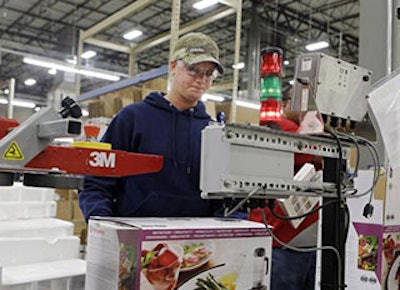
Internal and external factors — namely plant optimization and regulation compliance — are driving plants to bring more industrial computing resources onto the plant floor.
The introduction of historian devices, for example, is enabling plants to capture process data right in the controller. Having this data available at the decision point allows operators to react to it more quickly and better maintain expected output. Often, feedback is automatically sent back to the controller indicating part quality activating a diverter if bad. This feedback loop may require fast response putting high demands on the network where distance and traffic is critical.
Another example is labeling or serialization requirements. During the manufacturing process, products under such requirements need to be marked with a label or serial code so they can be traced at the lot, batch or individual-unit level. Without it, you are out of business. This process requires computing equipment to assign and record each label or number, and it only makes sense to implement that at the local machine for the fastest response and highest reliability.
Traditionally, the harsh environment of the plant floor has relegated computing equipment to a walled-off data center. Environmental factors — such as vibration, temperature, shock, dust and humidity — posed a danger to the operation, upkeep and safe usage of such equipment.
But that's changing.
Enclosures for a wide range of equipment are allowing plants to emigrate their industrial compute equipment onto the plant floor, closer to where the decisions are made. At the same time, the equipment itself is advancing for use on the plant floor. Hardened servers, for example, have been introduced that can operate in a climate of up to 120 degrees Fahrenheit for up to 8 hours of nonstop operation. Such capabilities were unheard of in the past.
This transition of computing equipment onto the plant floor raises an important question about who’s going to support it. Conditions on the plant floor can present just as much a challenge to workers as they can the equipment.
IT staff historically have been the “go-to” for servers and switches. But as manufacturing networks converge into a network architecture based on Converged Plant wide Ethernet (CPwE) and compute resources become more integrated into the plant — in some cases even inside the control panel — remote access is becoming the new normal, especially for IT staff.
Remote access allows IT staff to access industrial compute equipment from the comfort of their own desk and not have to go out onto the plant floor. Also, as IT equipment increasingly makes its way onto the plant floor and becomes integrated with the controls and other drives, the next generation of control engineers will be more familiar with the equipment. They, rather than IT staff, will mostly likely assume responsibility of managing it.
Preparing for the Change
Plant managers who decide to bring their industrial computing resources to the decision point should understand that the network infrastructure comes first. Plant managers should take a step back to first evaluate the physical architecture and assess the foundation to ensure it meets current and future needs. The goal is to strategically deploy computing resources close to the decision point while keeping those resources protected from the environment and delivering the necessary performance, power and security.
When taking this structured network approach, consider these key questions:
- Where do you need to deploy industrial compute resources as well as determining the performance requirements to meet the needs?
- How many devices need to be networked and what is the criticality of the connection?
- Where do you strategically locate switch zone enclosures and how many network ports are needed for today and the future?
- Does the location have reliable power and grounding necessary for the equipment and whether redundant power feeds are required?
- Does your existing network have the bandwidth and redundancy to support these resources, particularly as they grow in number and importance and what improvements may be needed?
Addressing these issues up front can be crucial to avoiding network sprawl. It also helps ensure that engineers and IT staff can maintain control of the network and better troubleshoot any issues.
Andy Banathy is with Panduit. Customers look to Panduit as a trusted advisor who works with them to address their most critical business challenges within their Data Center, Enterprise and Industrial environments.
To read more manufacturing and technology news, sign up for our newsletter. You can also follow Manufacturing Business Technology on Twitter @MBTwebsite.



















